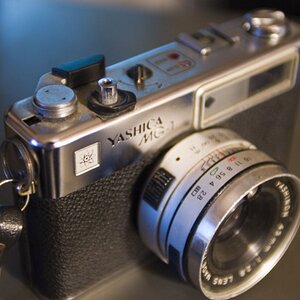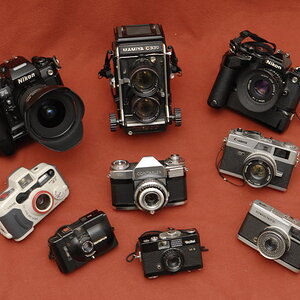photoguy99
No longer a newbie, moving up!
- Joined
- Mar 20, 2014
- Messages
- 1,485
- Reaction score
- 313
Eric Kim writes well, and his photos have a lot of visual pop, and he spent a lot of time getting a million followers on flickr and friends.
All these are pretty easy things to do, you just grind them out. Writing is probably the hardest, I know people who say it really can't be taught, just improved. I dunno about that. Photos with visual pop are trivially easy. Getting followers on flickr is just work.
His work is probably genuinely new looking to people who are fans. They think he invented it, or at least perfected it. Who am I to judge? It's a crazy old world. To me his photos are emotionally dead, lifeless copies of overdone cliches. But then, I've looked at a lot of photographs in my life. Who's to say that the ones *I* like are actually original and awesome, maybe they're just cheap copies of photos I don't know about. Probably not, but I can't be sure, can I?
HCB pulled paintings out of thin air, or off the contact sheet, if you like. Winogrand seems to have been mainly about human interactions, sometimes obvious, sometimes grotesque, sometimes opaque. Often, though he just liked the way a girl looked. Strand and Arbus did street portraits or something like that, of oddities. How would their work look today, without the originality they enjoyed? I dunno. Traditionally, "street" doesn't overlap with street portraiture at all, but in this modern world, "street" means whatever you want it to.
I like to think Arbus and Strand dug deeper, and made more important statements in their pictures. But maybe the importance lies in the time they were made, not in the photographs themselves.
Anyways. A great portrait, be is a street snap or the result of 8 hours of studio labor, gives us the impression of knowing the sitter, of telling the sitter's personal story in some meaningful way. It probably does not do this literally, but it makes us feel that it does. It makes us feel that we know this person and that we can imaging their life.
In a superficial way this is dead easy with a homeless guy. The story is right there. Went to war. Came back damaged. Got into drugs to ease the pain. Downward spiral. Pretty much nuts now, but was that the cause or the effect? The ease of the superficial, I think, worsens the photo. The individuality is gone, and the photo is of an idea of homelessness. The story of John Trigos-Jones is lost, unimaginable under the weight of the generic Homeless Story. And honestly, who the hell needs to hear the generic Homeless Story again?
All these are pretty easy things to do, you just grind them out. Writing is probably the hardest, I know people who say it really can't be taught, just improved. I dunno about that. Photos with visual pop are trivially easy. Getting followers on flickr is just work.
His work is probably genuinely new looking to people who are fans. They think he invented it, or at least perfected it. Who am I to judge? It's a crazy old world. To me his photos are emotionally dead, lifeless copies of overdone cliches. But then, I've looked at a lot of photographs in my life. Who's to say that the ones *I* like are actually original and awesome, maybe they're just cheap copies of photos I don't know about. Probably not, but I can't be sure, can I?
HCB pulled paintings out of thin air, or off the contact sheet, if you like. Winogrand seems to have been mainly about human interactions, sometimes obvious, sometimes grotesque, sometimes opaque. Often, though he just liked the way a girl looked. Strand and Arbus did street portraits or something like that, of oddities. How would their work look today, without the originality they enjoyed? I dunno. Traditionally, "street" doesn't overlap with street portraiture at all, but in this modern world, "street" means whatever you want it to.
I like to think Arbus and Strand dug deeper, and made more important statements in their pictures. But maybe the importance lies in the time they were made, not in the photographs themselves.
Anyways. A great portrait, be is a street snap or the result of 8 hours of studio labor, gives us the impression of knowing the sitter, of telling the sitter's personal story in some meaningful way. It probably does not do this literally, but it makes us feel that it does. It makes us feel that we know this person and that we can imaging their life.
In a superficial way this is dead easy with a homeless guy. The story is right there. Went to war. Came back damaged. Got into drugs to ease the pain. Downward spiral. Pretty much nuts now, but was that the cause or the effect? The ease of the superficial, I think, worsens the photo. The individuality is gone, and the photo is of an idea of homelessness. The story of John Trigos-Jones is lost, unimaginable under the weight of the generic Homeless Story. And honestly, who the hell needs to hear the generic Homeless Story again?




![[No title]](/data/xfmg/thumbnail/42/42021-ffc326f5dc5b4c65ce53935e6e9e4338.jpg?1619739980)

![[No title]](/data/xfmg/thumbnail/42/42026-4f14b406e4eb9c886f454721fb021fba.jpg?1619739982)




![[No title]](/data/xfmg/thumbnail/42/42019-e6f4e7422d2f8ec66dade714c8b21766.jpg?1619739979)

